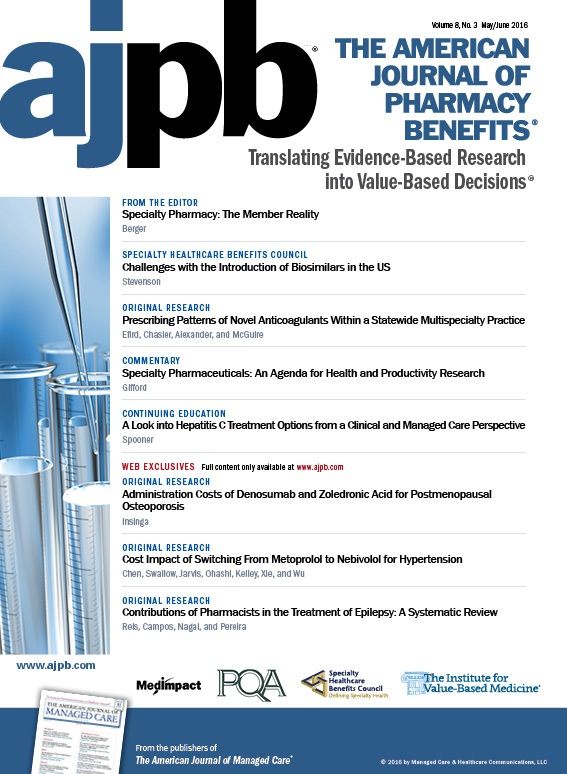Publication
Article
AJPB® Translating Evidence-Based Research Into Value-Based Decisions®
Specialty Pharmacy: The Member Reality
Author(s):
New high cost specialty medications are increasingly treating otherwise untreatable conditions, creating a series of challenges for stakeholders across the healthcare landscape.
If we were to look back 10 years in the pharmacy- and medication-focused world, we would find the following:
- Small molecule medications were the focus of members, providers, and payers.
- The issues surrounding medication costs focused on point of distribution and choice of generics or “preferred” medications.
- All of the medications in a payer “top 20” list were small molecule medications.
- Most of the support systems surrounding medications also focused on these small molecule medications.
- There was burgeoning knowledge about biologic medications with limited focus on cost and support issues.
Boy, how the world has changed. Today, more than 80% of small molecule medications that are used are generic medications. The main area of focus and concern among payers and providers on these medications is supporting medication adherence for these cost-effective medications.
The energy today has pivoted to specialty medications. The reasons for this focus, at least in part, depend on which stakeholder you may be. The issues include:
- For the most part, specialty medications have found themselves on most payer “top 10” lists.
- The cost of these medications continues to increase and has affected both payers and patients. (Only recently, as payment models have changed, has cost had a significant impact on providers.)
- There are a growing number of specialty medications that appear on most payer “top 20” lists.
- Although some of the support activities for patients associated with specialty medications are similar to those of small molecule medications, there are many activities that were not considered or needed in the past.
In order to understand the support that needs to surround specialty medications, one only needs to look at the lifecycle of these medications in a patient’s world. The first issue that is identified is drug choice.
Historically, medication choices were made by the physician, either based on medications that they were comfortable with or on those medications that had lower-tier status on the patient’s formulary. The increased availability and use of specialty medications coincided with the increased availability of companion testing and genomic alignment.
Only recently have there been multiple specialty medications in a class that can allow for cost compression. The earliest classes in which we found examples of this include medications such as growth hormones, rheumatoid arthritis medications, and medications for hepatitis C. It is likely that decisions associated with appropriate medication choice will continue to be more complicated as precision medicine matures.
The second area of support associated with specialty medications is drug distribution. With small molecule medications, the distribution model was based on either a retail or mail distribution for the patient. Initially, specialty medications were also predominately distributed through retail pharmacies or, in the case of injectable or infusible medications, were distributed through the physician’s office.
Over the last 10 years, specialty medications have increasingly been distributed through specialty pharmacies. As the world of specialty medications has continued to grow, the role of specialty pharmacies has grown. Many of these organizations have limited specialty medications through their specific distribution channels. This has brought both greater support and greater challenges to those utilizing these medications.
The activities associated with the distribution of specialty medications have been found to be of value to many patients, and the support associated with that distribution has included pharmacist and nurse education by those with focused knowledge of the condition, as well as the medication. This support level is often not available at the retail pharmacy, as many of these conditions are rare and therefore not seen by most retail pharmacists on a regular basis.
Many patients find this specialized support quite helpful when it comes to the complicated regimens often required. The challenge of the specialty pharmacy distribution model is that many patients find themselves in a situation where they are unable to find a physician who will infuse the medication because they, themselves, do not distribute the medication.
Physicians often state that they are uncomfortable infusing medications when they do not know where they came from or how they have been handled. This can place the patient in a very difficult situation. Most recently, a number of specialty pharmacies have begun to offer home infusion services that address this problem.
The third area of support necessary for many patients taking specialty medications is financial issues. This is not to say that patients taking small molecule medications do not, in some cases, have financial issues. However, cost is often a reason why people are noncompliant with their medications. The difference with specialty medications is that there tends to be greater financial barriers associated with them due to the significantly higher costs.
An increasing number of patients are stating that they have to forgo paying for other necessities in order to afford their medications. This has created an entire industry focused on medication payment assistance. In some cases, it is the pharmaceutical company that aids the patient with payment assistance. In other cases, it is the specialty pharmacy or an independent company that supports the patient with payment issues.
We are entering a period in healthcare where new specialty medications are treating otherwise untreatable conditions. What we have to make sure of is that we also address the challenges associated with specialty medications.
Are there other challenges that your organization is addressing? I look forward to hearing from you.







